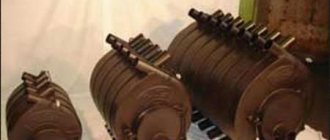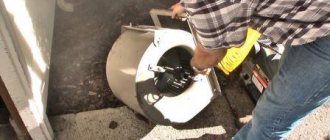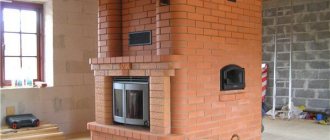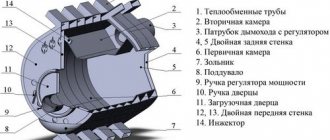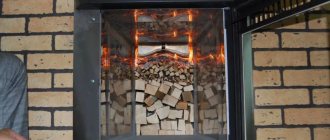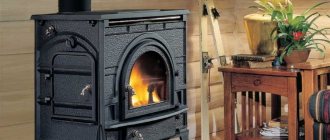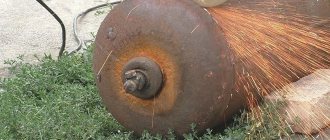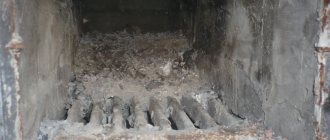Types of wood stoves
A wood stove is a universal device that can heat a small house and be connected to the heating system and water supply. Before purchasing, you need to study the features of the classification of heaters.
According to case material
Metal wood-burning stove for heating a house
Depending on the material of manufacture, a wood-burning stove can be:
- Cast iron. The thermal capacity of the housing and its ability to accumulate thermal energy ensure the operation of the device as auxiliary heating. A corrugated chimney or sleeve is designed to remove combustion products. The cast iron unit is equipped with a blower system to maintain temperature for a long time.
- Metal. Stainless metal reduces the time it takes to heat the air in the room. When purchasing, you should focus on the thickness of the walls - thin ones cool down very quickly. Structures with thick seams are less susceptible to cracking.
- Brick. It is built as the main source of heat and is equipped with a serpentine-shaped smoke pipe. Despite the long heating time, the brick can retain thermal energy for several hours.
A cast iron unit is suitable for installation anywhere, while a brick unit can be used for cooking.
Depending on the chimney design
External chimney for a stove
The chimney pipe removes combustion products and, depending on the installation method, can be internal or external. In the first case, it is located outdoors and has good traction. External systems are not routed through the roof and are used for aesthetic purposes.
Based on the type of construction, several types of chimneys can be distinguished:
- Wall. The lower part is combined with the foundation of the wall. The chimney is made of brick.
- Root. It is installed on a separate base near the outer wall, equipped with a brick or ceramic liner.
- Sandwich. The single-layer pipe has the form of a nozzle and is quickly mounted on a fireplace or stove.
- Coaxial system Schindel. A two-pipe design that injects air in a counter-current manner and removes combustion products.
The chimney should rise 5 m above the grate, and 1 m above the roof.
By type of design
Brick stove with stove
bench Reliable hearth stoves operate on wood and are designed for heating a house of any size. There are several types of devices based on their design.
A stove with a closed heater is suitable for installation in saunas or baths if it has a special compartment for laying stones. The heater is heated by convection or with an open flame. The water circuit is represented by a tank with pipes.
Russian stoves are made of brick and equipped with a sleeping place - a stove bench. The combustion chamber is located under the stove bench, the stove is next to the firebox. The heating intensity is adjusted through the blower. The Russian stove runs on a large amount of fuel and efficiently heats a room of more than 40 m2.
Depending on the location area in the room, you can choose fireplaces :
- Angular. Models with a built-in or attached chimney are placed in the outer corner. Rectangular or square are distinguished by a wide fireplace podium with a niche for fuel.
- Wall-mounted. The back of the structure is located near the wall. The average size of the base is 75x125 cm, which is suitable for living rooms in a small house.
- Island. They are built on a separate foundation in large rooms. Perform zoning and heating functions.
Depending on the functional purpose, you can choose a fireplace stove for a wood-burning sauna or a design with a hob.
Swedish stove for home heating and cooking
Swedish stoves are distinguished by a rear chimney outlet and are classified according to the type of section into several types:
- Vertical. Smoke exhaust duct with 2-3 elbows and a cleaning door.
- Horizontal. It is laid out horizontally, has at least 2 bends and heats up evenly.
- Kolpakovy. Warm air masses are retained in 2-3 chambers, the shield heats up evenly.
Hooded Swedes are the most difficult to operate and maintain.
Fuel combustion duration
A stove or fireplace with a long-burning system operates by burning pyrolysis gases, but wood-burning models are also divided into several types:
- With water circuit. They warm up large rooms efficiently, since the water type circuit is connected to heating radiators.
- No outline. Equipped with an afterburner chamber and a plate deflector. Primary air masses ignite the fuel, secondary air is supplied to the afterburner.
The long-burning system allows you to operate the stove with one load for 3-8 hours.
Main types of long-burning furnaces
In addition to the fact that these devices can be conventional and have a water circuit, they are also divided according to other criteria.
Thus, units of several modifications are produced:
- Heating models.
- Heating and cooking stoves with a hob and even an oven.
- Stoves with a tank for heating water.
- Multifunctional stoves that include all of the listed functions in their design.
Long-burning stoves can have different shapes and sizes - this variety allows you to choose the right option, depending on the area and installation location.
- Corner models of long-burning cast iron stoves usually have a compact size, so they can be installed even in the smallest room. It must be said that corner fixtures are most often made of various materials used in combination. For example, the body is made of high-quality steel 4÷5 mm thick, and the grate, combustion chamber and other internal elements in contact with open fire are made of cast iron.
Corner oven
- Wall heating devices can also vary greatly in size, depending on their functionality. They are intended for installation both in kitchens and living rooms, as they are often given a very original design design.
Cast iron stove with ceramic exterior
Quite often, cast iron stoves are lined with various types of ceramic tiles, or even artificial stone. This finish performs several functions at once:
— helps to retain the generated heat for a longer period;
- the surface of such a finish does not heat up to dangerously high temperatures, since ceramics have lower thermal conductivity compared to metal - there is a much lower chance of getting an accidental burn.
— finishing tiles will be an excellent decorative decoration for the surfaces of the stove, as they can have a variety of colors and relief patterns. Some of its types imitate tiled cladding.
You might be interested in information about what can be done from an old cast iron bathtub
Design and principle of operation of a wood-burning stove
Structural elements of a wood-burning stove
The modern type of wood-burning heaters consists of a chamber for storing fuel, cast-iron grates, an ash pan for collecting wood residues, and a chimney for removing residual gases. The lumber is placed in the fuel compartment and set on fire. The combustion reaction promotes the formation of gases with high temperatures. They, moving through the pipe, heat the walls of the device, which release heat into the room. The heating rate depends on the housing material.
To support the fire in the combustion chamber, a blower flap and a smoke valve are used. They are opened to a larger or smaller size. When excess air enters, the heat transfer of the structure decreases, and soot quickly appears in the chimney.
A standard stove will heat a house or cottage in an average of 5 hours.
Installation features
In order to control the combustion area, an air distributor is used. Oxygen is supplied through a pipe leading through the top cover. The unimpeded movement of the distributor is achieved due to the difference in diameters.
The thickness of the burning layer depends on the height of the impeller. It is recommended to pay special attention to this parameter. If the blade height is too high, the fuel will burn very quickly. It has been experimentally established that the optimal height should not exceed 50 mm.
The diameter of the air channel is selected to be at least 60 mm. A distributor opening size of more than 20 mm is considered excessive, since oxygen supersaturation increases the combustion intensity, which is unacceptable for a unit of this type. For a mixer for a warm water floor, read our article.
Specifications
The technical parameters of wood heaters depend on the material and manufacturer. Since brick structures are most often built in private houses, it is advisable to consider their parameters:
- comfortable room temperature – +23 degrees;
- thickness of the convection screen (if available) – 30-40 mm;
- scope of operation – heating, cooking, additional heating;
- weight – from 250 kg without metal parts;
- type of foundation – solid cast, strip;
- the size of the metal sheet in front of the firebox is at least 30x40 cm;
- chimney cross-section – from 140x140 mm to 200x270 mm;
- thermal power – from 3.5 to 14 kW.
A small stove for a sauna with an open heater.
For a sauna, you can build a mini-stove that runs on wood with the following characteristics:
- heat output - 12.1 kW;
- width – 50.5 cm;
- height to pipe – 72.5 cm;
- depth of the combustion compartment – 73.7 cm;
- weight – 360-370 kg.
The efficiency of the finished unit will be 70-75%.
Design differences and material for the manufacture of stoves with a long combustion cycle
Naturally, durable and high-temperature resistant material is used to make the stoves. It is also important that it has high thermal conductivity. Therefore, it is not surprising that most industrial designs are made of cast iron or thick-walled steel.
For self-construction of a furnace, refractory brick is a completely suitable material.
The main element of the stove is the firebox, which is large in size, and the maintenance of constant smoldering is ensured and regulated by a damper located for convenience on the front side.
Direct ignition is carried out in the upper compartment of the firebox, to which the chimney is directly connected.
The ovens are equipped with two dampers:
- the first, or inlet, is continuous and is designed to, if necessary, completely stop the air supply to the firebox;
- the chimney damper has a special cutout, approximately a quarter of its area, which ensures, even when completely closed, that combustion products do not block the exit to the chimney.
Convection channels, round or other cross-section, located around the combustion chamber are responsible for heat transfer. They are responsible for the process of air convection in the room, as they take heat from the stove and release it into the environment.
In some models, it is possible to use these ducts not only to directly heat the room in which the stove is installed, but also to connect air vents to them to transport heat to other rooms of the house.
If you plan to install a reliable unit, then you should pay attention to cast iron models. They have high heat transfer and can be used for a long time, but they have one significant drawback - they are heavy. Therefore, for their installation, you must first prepare a reliable foundation, for example, concrete.
Be sure to take precautions during installation, especially in wooden houses. In this case, it is necessary to maintain a minimum distance from the wall of at least 1-1.5 m, while first protecting it, for example, with a sheet of iron or brickwork.
When installing in a stone or brick house, it is also necessary to maintain a distance to the wall, but in this case 30-40 cm is sufficient.
If you are laying a stove for a brick house with your own hands, then you should first take care of the foundation for it. There are no special differences in design compared to conventional stoves, except that the combustion chamber should be several times larger.
In addition, in the upper part there must be a chamber for combustion of fuel gases, to which an exclusively straight chimney is directly connected.
This type of furnace does not have any particular advantages over industrial designs, for example, those made of cast iron, given the characteristic feature of its operation.
Settlement will occur on the walls very quickly and in large quantities, followed by coking of resins and ash, which will require regular cleaning of not only the chimney, but also the firebox itself. Therefore, some craftsmen additionally line the walls with metal sheets.
Advantages and disadvantages
Wood-burning stove with hob
The advantages of using wood-burning stove models include:
- versatility - suitable for cooking and heating;
- ease of adjustment of fuel combustion intensity;
- the ability to create a comfortable temperature in a large house;
- ease of installation of ready-made devices and construction of brick ones;
- minimum amount of emissions of harmful substances;
- durability of the structure;
- high efficiency - for models with long-term combustion systems it reaches 82%.
The downside of the units is the use of only one type of fuel and the difficulty of building brick modifications for beginners.
Advantages and disadvantages of long-burning cast iron stoves
Recently, owners of private houses are increasingly choosing cast-iron stoves with a long-burning function built into them, preferring them even to “classic” brick structures, and this is explained precisely by the numerous advantages of such factory-produced devices.
Long-burning cast iron stoves have many advantages that distinguish them
The advantages of such furnaces include the following qualities:
- High efficiency.
- With correctly selected oven power, it can effectively and quickly heat rooms from 0 to 20 °C in 25–30 minutes. But of course, in order for the device to function according to the characteristics declared by the manufacturer, it is necessary to properly thermally insulate the house.
- The stove can operate autonomously for 5÷12 hours, depending on the volume of the combustion chamber and the correct settings of the device. This quality allows you not to wait for the fuel to burn out before closing the chimney damper and keeping the house warm, since there is no danger of smoke in the rooms.
- Well-functioning cast iron stoves are convenient and easy to operate, which consists of adjusting the supply of first primary and then secondary air.
- Ease of installation and lower total costs when purchasing and installing such a device, compared to the construction of brick versions of stoves.
- The compactness of the unit allows it to be installed in any, even very small, room.
- Possibility of cooking and heating water.
- The modern design of cast iron stoves allows them to fit into an interior designed in any style.
Disadvantages of cast iron stoves:
It must be said that this device, seemingly impeccable in design, has its negative aspects, which, however, are completely surmountable. The “disadvantages” of long-burning stoves include the following features:
- It is necessary to insulate the chimney pipe, since without this condition the operation of a long-burning stove is impossible. Heated gases entering a cold pipe immediately form condensation and layers of soot deposits on its inner walls. In this regard, the chimney quickly becomes clogged and requires frequent cleaning, otherwise backdraft may form.
- If the settings are incorrect, complete decomposition of the wood and combustion of flue gases does not occur, which indicates that the capabilities of the stove are not fully used.
- For this type of unit it is necessary to purchase high quality fuel.
- High cost of the device. However, this drawback can be compensated for quickly enough, since fuel consumption when operating long-burning furnaces is several times less than for devices with a conventional firebox design.
Nuances of choosing a heater
When selecting a wood-burning stove, it is necessary to take into account working conditions, the specifics of the material, financial costs and personal preferences. Before purchasing a unit, you should pay attention to the following points:
- Brick structures are characterized by high heat transfer, but require financial investments in construction. Cast iron heats the room well and is installed without a foundation.
- Functional heating and cooking models are equipped with several burners and an oven.
- Pyrolysis devices ensure complete combustion of fuel.
- The optimal wall thickness of a furnace with a water circuit is from 75 mm.
- A unit with automatic fuel loading is loaded with circular sawn timber 10-15 cm thick.
- Due to their low efficiency, cooking and heating structures are suitable for rooms up to 25 m2.
- If you have a sauna or bathhouse, opt for a heater.
- The safest type of firebox is closed.
- It is easier to connect an expansion tank and heat exchangers to modifications with an oven.
Wood stoves require careful maintenance and compliance with operating conditions.
With or without water circuit
Gas-generating furnaces have proven themselves to be an efficient heating device even without connecting a water circuit.
Provided the power of the unit is chosen correctly, it will delight you with warmth and comfort. Depending on the specific operating conditions, you can choose a combined model with a hob and oven. Such devices are universal. In general, when operating a gas generator furnace, you can do without an additional water circuit. On the other hand, its connection will provide more comfortable conditions due to the use of two different heating networks - a stove and a radiator system with liquid coolant.
Unlike brick stoves, connecting a water circuit to a cast iron structure is not difficult. The heat exchanger is installed above the firebox. Such a jacket will go around the firebox, ensuring water heating. The coolant, circulating through pipes and radiators, makes heating a country house more efficient. As you can see, cast iron stoves are best used with a water circuit. At the same time, as practice has shown, it is better not to build a heat exchanger into a brick structure. This is due not only to the complexity of installation, but also to a number of nuances that are revealed during the operation of the device.
Installation recommendations
For a heavy brick oven, it is necessary to build a foundation.
During the installation of a heating device, several rules must be followed:
- Do not place flammable objects or explosive liquids near the heated area.
- It is better to clean the collapsible type of chimney from soot.
- The suitable diameter of the chimney pipe is approximately 15 cm, length – 5 cm.
- The chimney is equipped with an adjustable damper.
- To protect against burns, it is better to use brick shielding. The masonry will also prevent overheating of the walls and will accumulate heat.
- The floor surface made of combustible materials is protected by the foundation.
The complete instructions contain detailed installation instructions.
Ghisa La Nordica, Italy
The Italian company La Nordica was founded in 1968 and has been present on the wood heating market for the last 50 years. Products are supplied to 50 countries. The manufacturer's range includes ultra-modern, classic and rustic-style models - for heating, cooking, and water heating.
Our selection includes 3 models with female names.
All are made of cast iron and, which is quite rare, Isetta and Isotta implement convective heat transfer: there is space for air circulation between the firebox and the body. Another feature is the side loading door in the Isetta and Isotta models! At the same time, Giulietta is the simplest of the selection, suitable for seasonal use in the country. Main characteristics of Ghisa stoves from La Nordica
| Characteristic | Giulietta | Isetta | Isotta |
| power, kWt | 6 | 7 | 9 |
| Volume of heated room, m³ | 172 | 200 | 258 |
| Maximum log length, mm | 400 | ||
| Chimney diameter, mm | 120 | 150 | |
| Size, mm | 490x710x430 | 660x710x450 | 790x780x520 |
| Weight, kg | 105 | 150 | 190 |
| price, rub. | 84 700 | 105 700 | 127 400 |
Impressions from use. Such stoves are popular for their appearance and ease of use. They are more expensive than alternative options due to their Italian origin, but this is completely justified for those who want to solve the problem of heating a country house for the next 10 years. You can put logs up to 400 mm long into the firebox, and a full load is enough for 4-5 hours to maintain a comfortable temperature at -15°C outside. They quickly warm up rooms: Isotta at 9 kW in an insulated house of 100 m² increases the temperature from +5°C to +25°C in 1-1.5 hours at -5°C outside. Among the disadvantages, one can name only the top connection of the chimney.
Watch a short video of the Isotta model in action:
Operating rules
A fireplace, a small sauna stove or a wood-burning model with a steam generator should not create fire situations. The operation of wood heaters involves:
- Installation next to the combustion chamber of a metal sheet 2 mm thick. The length of the protective product is 30 cm, the extension beyond the brick structure is 15 cm.
- Installation of smoke exhaust systems for metal structures made of acid-resistant materials.
- Use for burning dry firewood stored indoors.
- Dense fuel laying - thick lumber is on top.
- Use thin dry twigs for ignition.
- Laying firewood with a gap of 1/5 of the height of the firebox to the roof.
The second batch of fuel can be added after at least 1 hour, for long-term combustion models - after 3-4 hours.
Wood-burning stove-fireplace META Marseille 14
RUR 74,900 Rating 4.5
1 reviews
This is a fireplace stove from a Russian manufacturer. It is made of durable cast iron, and its thickness varies from 8 to 14 mm. Some of the components for this stove are supplied directly from France, and the especially heat-resistant glass ceramics are made in Japan.
Thanks to this, the end result is a highly efficient device that is capable of heating a room of up to 250 square meters.
The fireplace is heated with both wood and regular coal burners. However, you should not use coal. The fireplace stove is capable of producing an even supply of heat throughout the house. There is also a convenient handle that allows you to open the doors with ease.
Advantages:
Quality materials; High heating power; There is a system that allows wood to burn for a long time; Affordable price;
Flaws:
There is no special compartment for firewood;
Power 14 kW Type closed Chimney yes Fuel wood Burning time 8 hours "clean glass" system yes Long burning system yes Ash box yes External body material cast iron Door material glass Lining fireclay Chimney diameter 15 cm Top connection to the chimney Dimensions (WxHxD) 55x113x43. 90 cm Weight 130 kg
4.5/ 5 rating
Popular wood stove models
Model range of stoves Professor Butakov
In order not to waste time and money on building a massive brick structure, you can purchase a ready-made potbelly stove, heating and cooking or sauna modification. Several brands are popular in the domestic market.
Burelyan
Canadian device with ducted heating system. The powerful stove is suitable for installation in a home, utility room, workshop, or garage. Works on all types of solid fuel, with the exception of coal. It heats up in 10-15 minutes, the second load of firewood can be done after 8-10 hours.
Breneran
Russian brand that released the AOT-08 model. The floor-standing wood burning unit is equipped with a long combustion system. Installed in residential buildings, workshops, workshops. The firebox has a volume of 50 liters, which is suitable for heating a space of 140 m2. Thermal power is 8 kW, the second loading of firewood is carried out after 10-12 hours.
Professor Butakov
Notable design features are a rectangular body, an internal firebox, the presence of a pyrolysis afterburning chamber and convection pipes. The intensity of air supply is regulated by a damper. The line includes 4 devices:
- Student with a power of 9 kW and a firebox of 60 liters.
- Engineer - equipped with a 120-liter firebox and a power of 15 kW.
- Associate Professor - a stove with a thermal power of 25 kW and a firebox capacity of 250 liters.
- Professor - power is 40 kW, firebox volume is 500 liters.
The cooking surface is flat, suitable for heating food.
Termofor
Termofor stoves of the domestic brand
. A Russian brand that produces convection units of the Fire-Battery brand. The selection of the unit is carried out according to several parameters:
- Fire-Battery 5 – with a width of 37 cm, a length of 55.5 cm and a height of 76 cm, it has a power of 6 kW. Designed for heating rooms with a volume of 100 cubic meters and an area of 60-70 square meters.
- Fire-Battery 7 – differs from the previous model in length (68 cm), power (10 kW). It efficiently heats a house of 100-110 m2 and a room of 150 m3.
- Fire-Battery 9 – power is 13 kW. The length of the device is 80.5 cm. It is installed in houses of 130-10 square meters and rooms with a volume of 200 cubic meters.
- Fire-Battery 11 is a modification with a length of 93 cm. Designed for heating a space of 250 m3 in volume and an area of 160-170 square meters.
The digital index in the name of the Fire-Battery ovens indicates the number of convection pairs.
Several popular models of long-burning cast iron stoves
In order to make it easier to choose a long-burning cast iron stove, it makes sense to consider several models that, perhaps, will immediately appeal to someone.
Long-burning heating and cooking stove “ISOTTA CON CERCHI”
Cast iron stove "ISOTTA CON CERCHI", designed for additional or main heating of residential premises. It can operate in normal mode or as a long-burning device.
Cast iron stove "ISOTTA CON CERCHI"
The oven is made of high-quality cast iron and has double walls, between which heated air flows circulate. The model is equipped with a hob that can be closed with a protective lid if necessary. During cooking, this hinged panel serves as a protective screen for the wall and prevents greasy drips, steam and other contaminants from entering it.
The oven design includes a side loading door for loading longer logs.
The combustion door has panoramic heat-resistant glass that can withstand heating up to 750 degrees. The glass door also allows you to use this stove model as a fireplace, since the playing flames are clearly visible through it.
The drawing, with the dimensions indicated on it, looks like this. Using it, you can “try on” this version of the stove in its intended place.
Drawing of the furnace "ISOTTA CON CERCHI"
The table below summarizes the main technical characteristics of this device, which will also help you make your choice:
| Name of characteristics | Options |
| Manufacturer country | Italy |
| Material of manufacture | cast iron |
| Rated thermal power | 9 kW |
| Heated area | 258 m³ |
| Hob | Equipped with one burner |
| Chimney diameter | 150 mm |
| Structure height (including cover) | 830 mm |
| Width | 795 mm |
| Depth | 520 mm |
| Device weight | 203 kg |
| Efficiency | 0.85 |
| Fuel combustion coefficient. | 0.97 |
| Firebox size "Ghisa" | 597×422×350 mm |
| Fire door size | 519×305 mm |
| Hourly fuel consumption | 2.5 kg/h |
| Primary air supply | Yes |
| Secondary air supply | Yes |
| Side loading door | Yes |
Additional useful information provided by the manufacturer:
- This model is capable of working on firewood, pellets and fuel briquettes; the use of brown coal is acceptable.
- The service life declared by the manufacturer is at least 35 years.
- A sufficiently large surface area of the stove warms up well and transfers heat to the premises.
- The door of the air supply channel, which serves as a regulator of the combustion intensity of the fire, can be closed completely, creating the necessary conditions for long-term combustion, that is, the smoldering of firewood with the release of pyrolysis gases and their subsequent afterburning.
- The secondary air supply channel plays an important role in the process of afterburning the released pyrolysis gas. In addition, it serves to blow glass to protect against deposits formed during combustion - soot and soot.
- A well-adjustable gate valve will help ensure optimal traction, extend the service life of the device, as well as ensure quick ignition without smoke and increase efficiency.
- The lid installed on the hob has an automatic stopper that snaps into place when it is opened and locks it in the desired position.
The oven is capable of heating up to 260 m³ (100 ²) of volume in less than an hour. While in the heat maintenance mode, the outer walls of the stove heat up to 80–85 degrees, and it works like a decorative fireplace that heats a small area.
When the stove is set to long-burning mode, it is able to maintain heat for 8-10 hours, and its efficiency can reach 90%.
Prices for ISOTTA CON CERCHI
ISOTTA CON CERCHI
Long-burning heating stove "INVICTA Carolo"
Long-burning cast iron heating stove “INVICTA Carolo”
The INVICTA Carolo long-burning heating stove model is equipped with heat-resistant glass and slot convectors. This model has the following technical characteristics:
| Name of characteristics | Options |
| Manufacturer country | France |
| Material of manufacture | cast iron |
| Rated thermal power | 10 kW/h |
| Chimney diameter | 150 mm |
| Structure height | 690 mm |
| Width | 620 mm |
| Depth | 439 mm |
| Device weight | 118 kg |
| Efficiency | 0.783 |
| Heated volume of premises | 130÷400 m³ |
| Fireplace glass size | 500×400 mm |
"INVICTA Carolo" is made entirely of cast iron and has double walls, which significantly increases the efficiency of the device. The heating device is equipped with two channels for supplying primary and secondary air, which allows the use of a system for afterburning pyrolysis gas released from wood. The design of the device ensures constant slow combustion from 6 to 10 hours on one load of fuel.
The stove is capable of heating rooms with a total area of 100 m², subject to high-quality insulation of the house.
"INVICTA Carolo" is made in a classic style and has a rectangular shape. A fairly large heat-resistant glass is equipped with a self-cleaning system, which allows you to see the mesmerizing reflections of the flame. Therefore, the stove can easily be used as a fireplace for spending pleasant evenings, sitting with a cup of tea near the fire. And this despite the fact that about 25% of thermal radiation enters the room through the glazed door.
You may be interested in information about what types of long-burning wood-burning fireplaces for summer cottages are available
Long burning stove made of cast iron "Gomont"
The Gomont fireplace stove has a rather elegant appearance, different from the appliance options mentioned above. Made in a discreet style, it will fit into any modern interior. The glass in the door is made from heat-resistant glass ceramics “SCHOTT ROBAX”, which is resistant to high temperatures. The large size of the transparent part of the door, which is equipped with a self-cleaning system, allows you to observe the beautiful processes occurring in the combustion chamber.
Cast iron fireplace stove “Gomont”
The technical characteristics of the Gomont stove are as follows:
| Name of characteristics | Options |
| Manufacturer country | France |
| Material of manufacture | cast iron |
| Rated thermal power | 10 kW/h |
| Chimney diameter | 150 mm |
| Structure height | 977 mm |
| Width | 513 mm |
| Depth | 415 mm |
| Device weight | 103 kg |
| Efficiency | 0.76 |
| Heated volume of premises | 130÷400 m³ |
The furnace has channels for supplying primary and secondary air. There is a spacious ash drawer, which is hidden behind the oven door. Adjustment of the fire burning intensity, as in all long-burning stoves, occurs by supplying more or less air flow.
The manufacturer's warranty for this product is 5 years.
You may be interested in information on how to build a flint stove with your own hands (drawings)
Another example of a long-burning cast iron stove made in France is in the attached video:
Video: Tomera cast iron stove
Long-burning stove-fireplace “La Nordica Rosa”
This version of the stove has an original design, which is perfect for both modern and retro-style furnishings. Its external decoration is not only decorative, but also functional, as it is capable of keeping the device hot for a long time, but preventing its external surfaces from heating up to too high, dangerous temperatures.
A very original and functional model - long-burning stove-fireplace “La Nordica Rosa”
This version of the heating and cooking stove is made of several materials, so it can be called combined.
Its internal structure is made of high-quality cast iron, and the body is made of high-grade steel. The cladding made of natural stone or ceramics gives the model an aesthetic and elegant appearance.
The oven is equipped with a hob and oven, which has an internal heat-resistant enamel coating.
The technical characteristics of this device are given in the table:
| Name of characteristics | Options |
| Manufacturer country | Italy |
| Material of manufacture | cast iron, steel |
| Rated thermal power | 8.1 kW/h |
| Hob | Equipped with one burner |
| Chimney diameter | 150 mm |
| Structure height | 851 mm |
| Width | 1030 mm |
| Depth | 665.9mm |
| Device weight | 183 kg |
| Efficiency | 0.81 |
| Door glass size | 349×235 mm |
| .Heated area | up to 85 m² |
| Weight | 210÷226 kg |
| Firebox type | Closed |
| Double combustion chamber | Yes |
The device has channels for supplying primary and secondary air, which allows you to adjust the air flows entering the combustion chambers from the outside. The glass is made of glass ceramics that can withstand temperatures of 750 degrees.
The stove is capable, with good adjustment, of burning one load of firewood with effective heat transfer to the premises for at least 8–9 hours.
The stoves are available in two color finishes - burgundy and beige (cappuccino), which also helps them adapt to different interiors.
In conclusion, it should be added that the range of long-burning cast iron heating stoves is so large that it is possible to choose an option for every taste and income. There are models that are simple in design and design, which have a relatively low cost - they are perfect for installation in the country. And if desired and possible, you can also find expensive options lined with decorative ceramic tiles, perfect not only for heating needs, but also for decorating any, even the richest, living room. You can find out the calculator for calculating the heating of a private house by following the link.
You might be interested in information about how a two-bell heating stove works
Prices for La Nordica Rosa
La Nordica Rosa
Types of cast iron stoves
By design, wood-burning stoves for summer cottages can be divided into two types: traditional and long-burning. The division is conditional for the following reason: manufacturers are trying in every possible way to increase the efficiency and duration of operation of heaters from one stack of firewood, therefore, even in simple products, various technical solutions are being introduced. Thus, the boundary between one type of oven and another is very blurred.
The potbelly stove is rightfully considered the ancestor of all iron stoves. It came to us from the end of the century before last, characterized by low efficiency (15%) and incredible fuel consumption. This has not become an obstacle to its use at the present time, since the potbelly stove has found a second life thanks to several improvements. Accordingly, a potbelly stove is a modern traditional direct burning wood stove.
Initially, cast iron stoves were a rectangular body on legs with a chimney pipe located in the rear and directed upward. There was a loading door in front, but there were no grates; firewood was burned directly on the bottom of the stove. In this case, the lion's share of the thermal energy flew out into the chimney, since there was no provision for the extraction of heat from the combustion products. Nowadays, all potbelly stoves have a cast-iron grate, and underneath it there is an ash chamber with an additional door or a pull-out ash drawer.
To extract heat from combustion products, partitions of various designs began to be installed inside the furnace, trapping the exhaust gases and forcing them to go through a tortuous path and make several moves in different directions. This method allows for efficient heat exchange and more energy to heat a private country house. Many manufacturers began to install a window made of fireproof glass in the loading door, giving the potbelly stove an aesthetic appearance.
To increase functionality, water heat exchangers and hobs began to be built into potbelly stoves. Heat exchangers are used of the water-tube type or in the form of a water jacket, like in solid fuel boilers, only the jacket in the stove covers one wall of the firebox, and not all. Thanks to this, a cast iron stove with a water circuit can serve as a water heater for domestic hot water needs or for connecting a small radiator heating system.
Video review of the LAWA heating and cooking stove
If the firewood used is perfectly dried, then the amount of thermal energy released increases significantly. Regarding breeds, it is recommended to use the following:
- Hornbeam.
- Birch.
- Maple.
- Oak.
Important! The duration of operation of the unit during the combustion of one bookmark directly depends on its type. Thus, conventional models often do not work longer than four to five hours, but long-burning units can last all ten!
Now let's talk about what types of heating wood stoves exist.
Criterias of choice
A country house only needs periodic heating, so the fireplace stove must withstand long breaks in operation. In addition, it should warm up as quickly as possible and have high heat transfer. It is also worth choosing a device that can work for a long time on one kindling and retain heat.
It is best to select a device that can operate not only on wood, but also on some other type of fuel. This is explained by the fact that in winter it is not always possible to find dry and high-quality wood for kindling. Ideally, choose a combined design; such models have not only a heating surface, but also a hob. So you can always heat water or cook food.
From this video you will learn the specifics of the Baron cast iron stove from Eurokom:
https://youtube.com/watch?v=1w1vRLs83Y0
In addition, the heater should not be too bulky; it is better to give preference to compact stoves that are simple and easy to use. Basically, modern cast iron heating devices intended for summer cottages meet all these requirements.
Features of using a wood stove
All wood stoves today are made of steel. The walls of the firebox usually have a small thickness - based on wood or similar fuel (pellets, sawdust), which is characterized by a relatively low combustion temperature. If such a stove is heated with coal, it will quickly burn out.
By design, all heat generators of this type are convectors. The firebox of the device is washed by an air flow that moves from bottom to top due to convection and takes away about 70% of the generated thermal energy. At the same time, the body remains relatively cold, which makes the oven safe.
Air movement through the furnace is carried out through vertical pipes, recessed into the firebox by 2/3 of their diameter. An air duct leading to the next room can be connected to any of these pipes. Thus, one stove can heat several rooms without resorting to a coolant liquid.
Wood stove in the country
The chimneys of wood-burning stoves are subject to higher requirements than in the case of gas equipment. This is due to the presence in flue gases of a large amount of oxides of various elements, for example, sulfur, which, when reacting with condensing moisture, form acids.
In this regard, it is necessary to use acid-resistant steel to make the chimney and pay a lot of attention to its tightness: if condensation leaks into the room, it will harm its inhabitants.
